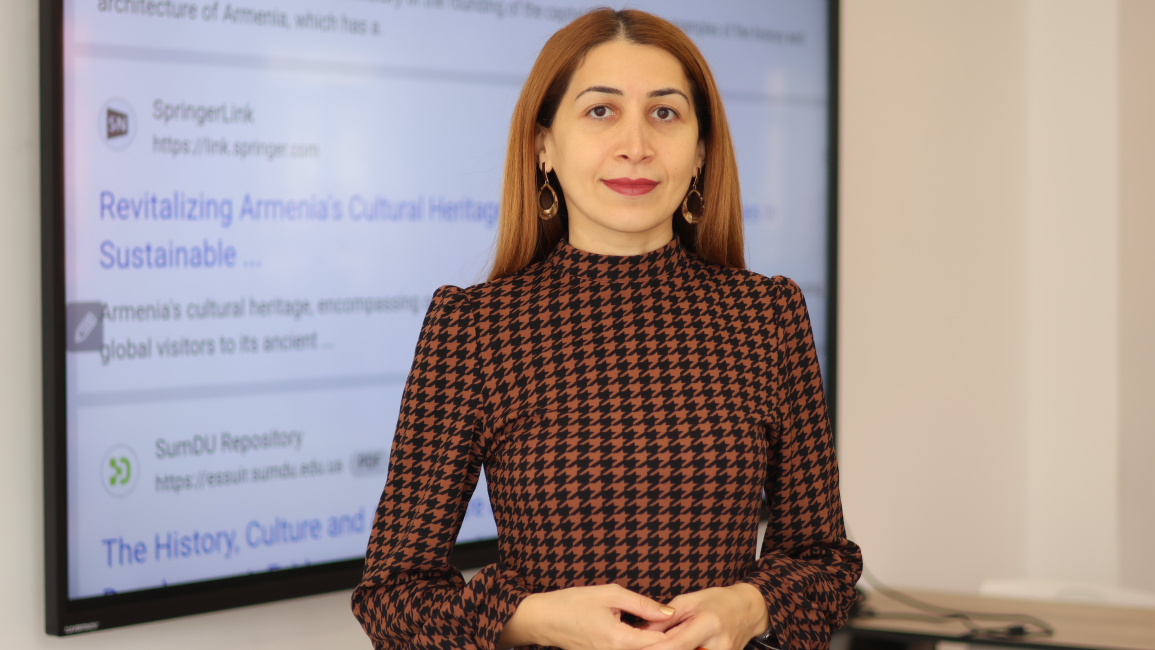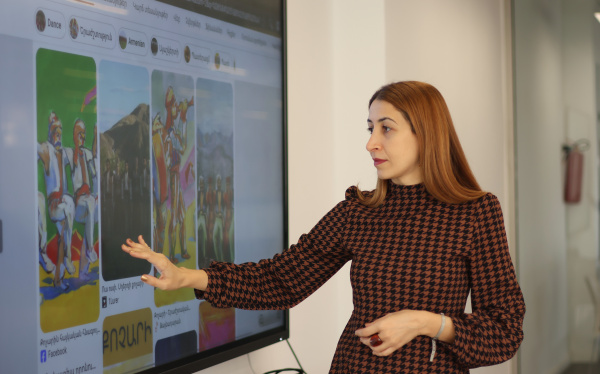October 31, 2025 | 16:05
Research
Publications and scientific journals
International cooperation
Latest digital technologies as tools for promoting cultural heritage and enriching tourism experiences
The application of digital technologies can significantly contribute to the preservation and appreciation of Armenia's cultural heritage, as well as to the development of tourism. This idea is affirmed by Associate Professor Gayane Tovmasyan, PhD in Economics, lecturer at YSU Faculty of Theology, who says, "By holding a phone in front of the ruins of the Zvartnots Cathedral, we can see what it looked like in the past. It is also possible to recreate historical events—for instance, to visualize what Tigranes the Great might have said in a particular situation."

Associate Professor Gayane Tovmasyan's article, titled "Revitalizing Armenia's Cultural Heritage: The Role of Digital Technologies in Sustainable Cultural Tourism", has been published in the high-ranking scientific journal "Advances in Science, Technology and Innovation", which is indexed in the Scopus database.
The article explores both the tangible and intangible aspects of Armenia's cultural heritage and the opportunities for tourism development based on them. It also addresses the key challenges still present in the field and, most importantly, emphasizes the use of modern digital tools to foster the preservation, appreciation, and popularization of Armenia's cultural heritage.
– Ms. Tovmasyan, which digital technologies have you discussed in your article?
– In recent years, digital technologies have become integral to nearly every sphere of our lives, and tourism is no exception. These include technologies that enable the creation of virtual tours and exhibitions—an approach that proved particularly relevant during the COVID-19 pandemic, when many museums abroad launched virtual galleries and exhibitions.

The article proposes several ways to apply digital technologies: organizing virtual tours; creating virtual exhibitions and displays by museums; developing interactive digital maps; and using QR codes at cultural heritage sites, allowing tourists to gain historical information by scanning them with their mobile phones.
The article also proposes introducing digital tour guides: by downloading a relevant app in advance, visitors can access detailed information about a site without paying for a tour guide. Offline maps are also available, allowing easier navigation in various locations.
Virtual Reality (VR) and Augmented Reality (AR) offer new opportunities for developing tourism. For instance, AR allows users to point their phone at a site and see what it looked like centuries ago, such as visualizing the original form of the Zvartnots Cathedral. Moreover, holographic displays can recreate and reinterpret historical events—for example, illustrating what Tigranes the Great said or did in a given situation. Through such tools, tourists are immersed in another dimension, witnessing significant historical moments and events.
– Which of these technologies are currently used in Armenia?
– In some parts of Armenia, QR codes are already available, allowing tourists to access relevant information. Certain online platforms also present specific elements of the country's cultural and historical heritage.
The article suggests creating a comprehensive virtual map of all cultural and historical monuments in Armenia. With over 24,000 such monuments spread across the country, many currently lack any online representation. However, most tourists prefer to gather information in advance before visiting Armenia. In this regard, it is good that several Armenian sites and elements of intangible cultural heritage are included in the UNESCO World Heritage List—information about which is accessible to foreign visitors. Thus, creating such websites and promoting their use will make information more complete and easily accessible.
– In your view, should priority be given to museums or historical monuments when introducing digital technologies?
– When it comes to historical monuments, preservation remains a major issue. Digital technologies may play an important role here by creating a database, increasing access to information through virtual platforms, and enhancing visibility using 360-degree videos and drone footage.
In museums, the application of such technologies will promote the development of museum tourism, as digital technologies are now widely used in this field worldwide. If we aim for progress, it is increasingly impossible to envision any sector without the use of digital technologies. From my own experience, I can give one example: at the Fryderyk Chopin Museum in Warsaw, there was a separate room equipped with computers and headphones, providing visitors with access to Chopin's complete musical legacy. Similar technologies may be used in Armenia as well, for instance, at the Aram Khachaturian House-Museum.
– The title of your article suggests that digital technologies can also help revitalize Armenian cultural heritage. Should this responsibility fall solely on the relevant authorities, and are the required costs substantial?
– Multiple stakeholders must be involved, as cultural monuments and museums often fall under different jurisdictions—some are of community importance, others under the Yerevan Municipality, or the Ministry of Education, Science, Culture and Sports. Therefore, close cooperation among all relevant institutions is essential.
Within this framework, the Tourism Committee of the Ministry of Economy may provide valuable consultancy, particularly by sharing global best practices and presenting innovations used in international tourism. The costs, naturally, are considerable.
However, in the 21st century, tourism cannot develop without digital technologies. We must fully utilize the opportunities and advantages they offer—to preserve and promote cultural heritage, ensure the comprehensive collection of information about it, and provide full access through online platforms. This will also enhance international awareness and recognition of Armenia's cultural legacy.
Tourism is the main focus of Gayane Tovmasyan’s research. She has authored more than 140 scientific publications, 25 of which are indexed in Scopus and Web of Science. In addition, she has authored approximately 10 monographs, 4 educational manuals, and one university textbook.

